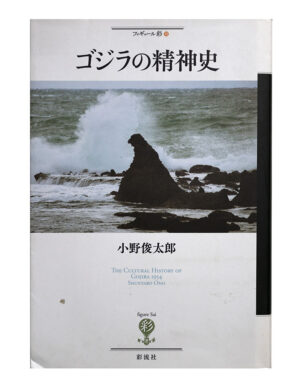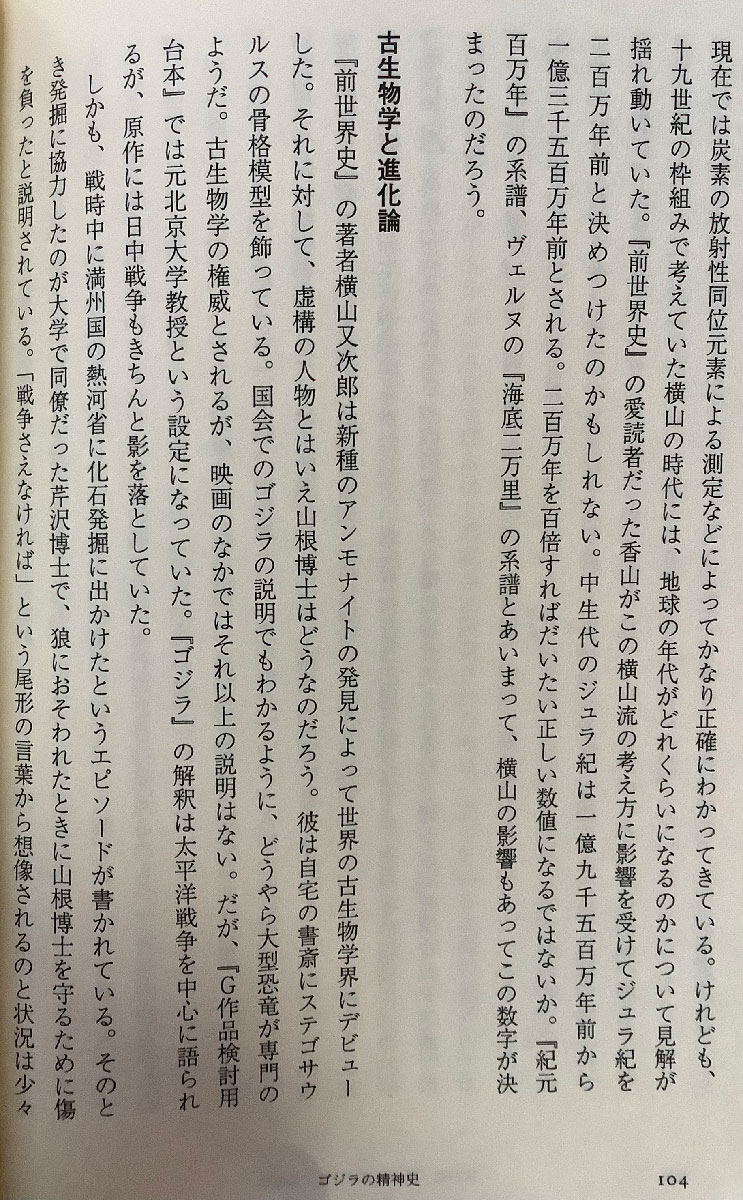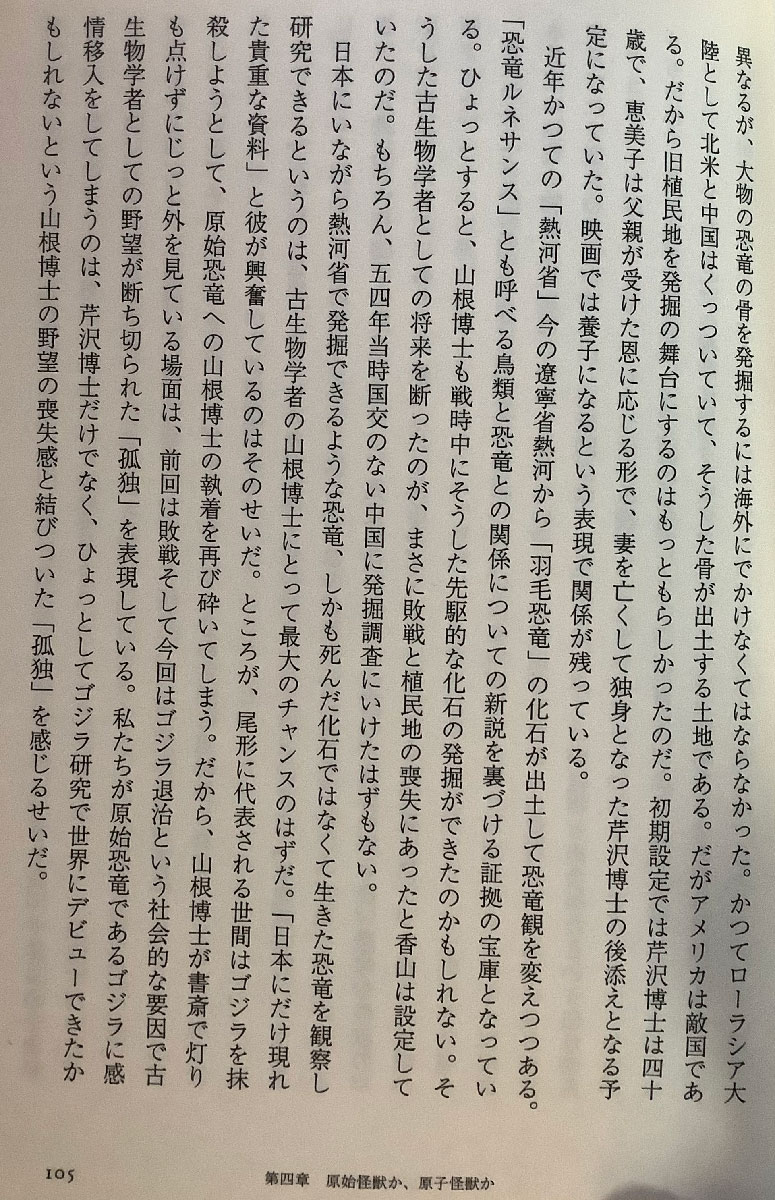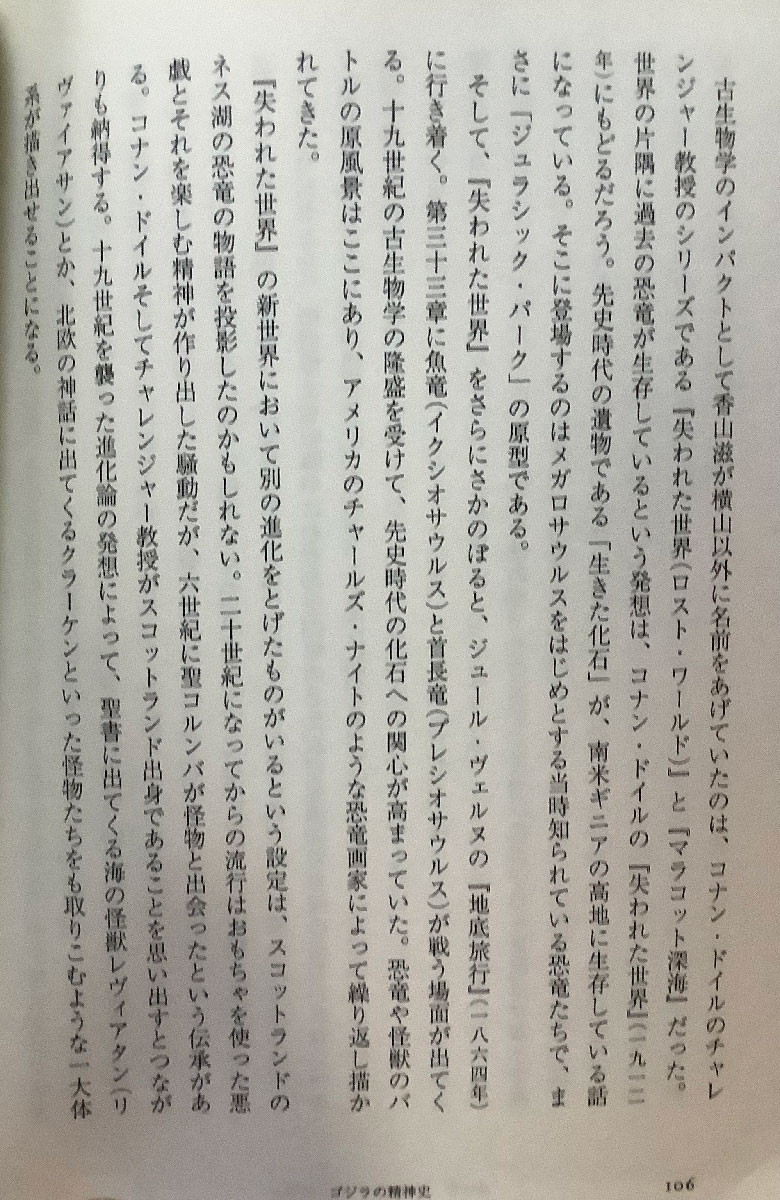4.28.2023
The Cultural History of Godzilla – Pt 41


P 104
現在では炭素の放射性同位元素による測定などによってかなり正確にわかってきている。けれども、十九世紀の枠組みで考えていた横山の時代には、地球の年代がどれくらいになるのかについて見解が揺れ動いていた。『前世界史』の愛読者だった香山がこの横山流の考え方に影響を受けてジュラ紀を二百万年前と決めつけたのかもしれない。中生代のジュラ紀は一億九千五百万年前から一億三千五百万年前とされる。二百万年を百倍すればだいたい正しい数値になるではないか。『紀元百万年』の系譜、ヴェルヌの『海底二万里』の系譜とあいまって、横山の影響もあってこの数字が決まったのだろう。
At present, it is being understood with considerable accuracy through measurements using radioactive isotopes of carbon. However, in Yokoyama’s time, when he was thinking in the framework of the 19th century, there was a wavering of opinions about how old the earth would be. Kayama, who was an avid reader of “Pre-World History,” may have been influenced by the way of thinking of this Yokoyama school and decided that the Jurassic period was two million years ago. The Mesozoic Jurassic period is from 195 million years ago to 135 million years ago. Multiplying 2 million years by 100 would give a more or less correct number. Yokoyama’s influence, combined with the genealogy of “One Million Years A.D.” and Verne’s “Twenty Thousand Leagues Under the Sea,” probably determined this number.
古生物学と進化論
Paleontology and evolution
『前世界史』の著者横山又次郎は新種のアンモナイトの発見によって世界の古生物学界にデビューした。それに対して、虚構の人物とはいえ山根博士はどうなのだろう。彼は自宅の書斎にステゴサウルスの骨格模型を飾っている。国会でのゴジラの説明でもわかるように、どうやら大型恐竜が専門のようだ。古生物学の権威とされるが、映画のなかではそれ以上の説明はない。だが、『G作品検討用台本』では元北京大学教授という設定になっていた。『ゴジラ』の解釈は太平洋戦争を中心に語られるが、原作には日中戦争もきちんと影を落としていた。
Matajiro Yokoyama, the author of “Pre-World History,” made his debut in the world of paleontology with the discovery of a new species of ammonite. On the other hand, what about Dr. Yamane, even though he is a fictional character? He has a stegosaurus skeleton in his home study. As you can see from the explanation of Godzilla at the Diet, it seems that he specializes in large dinosaurs. Considered an authority on paleontology, there is no further explanation in the film. However, in “G work review script,” he was set as a former Peking University professor. Interpretation of “Godzilla” is centered around the Pacific War, but the Sino-Japanese War was properly cast a shadow in the original work.
しかも、戦時中に満州国の熱河省に化石発掘に出かけたというエピソードが書かれている。そのとき発掘に協力したのが大学で同僚だった芹沢博士で、狼におそわれたときに山根博士を守るために傷を負ったと説明されている。「戦争さえなければ」という尾形の言葉から想像されるのと状況は少々異なるが、大物の恐竜の骨を発掘するには海外にでかけなくてはならなかった。
Moreover, there is an episode that he went to excavate fossils in Atagawa Province in Manchukuo during the war. At that time, Dr. Serizawa, a colleague at university, cooperated in the excavation, and it is explained that he was injured to protect Dr. Yamane when he was attacked by a wolf. The situation is a little different from what Ogata imagined when he said, “If only there wasn’t a war,” but in order to excavate the bones of a big dinosaur, he had to go abroad.

P 105
かつてローラシア大陸として北米と中国はくっついていて、そうした骨が出土する土地である。だがアメリカは敵国である。だから旧植民地を発掘の舞台にするのはもっともらしかったのだ。初期設定では芹沢博士は四十歳で、恵美子は父親が受けた恩に応じる形で、妻を亡くして独身となった芹沢博士の後添えとなる予定になっていた。映画では養子になるという表現で関係が残っている。
North America and China were once joined together as the continent of Laurasia, and this is the land from which such bones are unearthed. But America is the enemy. So it seemed plausible to use the former colony as the setting for the excavation. In the initial settings, Dr. Serizawa was 40 years old, and Emiko was supposed to follow Dr. Serizawa, who lost his wife and became single, in a way that reciprocates the favor that her father received. In the film, the relationship remains with the representation that she will be adopted.
近年かつての「熱河省」今の遼寧省熱河から「羽毛恐竜」の化石が出土して恐竜観を変えつつある。「恐竜ルネサンス」とも呼べる鳥類と恐竜との関係についての新説を裏づける証拠の宝庫となっている。ひょっとすると、山根博士も戦時中にそうした先駆的な化石の発掘ができたのかもしれない。そうした古生物学者としての将来を断ったのが、まさに敗戦と植民地の喪失にあったと香山は設定していたのだ。もちろん、五四年当時国交のない中国に発掘調査にいけたはずもない。
In recent years, fossils of “feathered dinosaurs” have been excavated from the former “Rehe Province” and the present-day Rehe Province, Liaoning Province, and the view of dinosaurs is changing. It provides a wealth of evidence to support new theories about the relationship between birds and dinosaurs, dubbed the “dinosaur renaissance.” Perhaps Dr. Yamane was also able to excavate such pioneering fossils during the war. Kayama assumed that it was the defeat in the war and the loss of the colony that cut off his future as a paleontologist. Of course, in 1954, it would have been impossible to go to China, which had no diplomatic relations, for excavation research.
日本にいながら熱河省で発掘できるような恐竜、しかも死んだ化石ではなくて生きた恐竜を観察し研究できるというのは、古生物学者の山根博士にとって最大のチャンスのはずだ。「日本にだけ現れた貴重な資料」と彼が興奮しているのはそのせいだ。ところが、尾形に代表される世間はゴジラを抹殺しようとして、原始恐竜への山根博士の執着を再び砕いてしまう。だから、山根博士が書斎で灯りも点けずにじっと外を見ている場面は、前回は敗戦そして今回はゴジラ退治という社会的な要因で古生物学者としての野望が断ち切られた「孤独」を表現している。私たちが原始恐竜であるゴジラに感情移入をしてしまうのは、芹沢博士だけでなく、ひょっとしてゴジラ研究で世界にデビューできたかもしれないという山根博士の野望の喪失感と結びついた「孤独」を感じるせいだ。
For paleontologist Dr. Yamane, being able to observe and study dinosaurs that can be excavated in Atagawa, and not dead fossils, should be the greatest opportunity for paleontologist Dr. Yamane. That is why he is so excited, saying, “This is a valuable document that only appeared in Japan.” However, the world represented by Ogata tries to kill Godzilla and breaks Dr. Yamane’s obsession with primitive dinosaurs again. Therefore, the scene in which Dr. Yamane is staring out in his study without even turning on the light expresses the ‘loneliness’ in which his ambition as a paleontologist was cut off due to the social factors of losing the war last time and exterminating Godzilla this time. It is not only Dr. Serizawa that we empathize with Godzilla, a primitive dinosaur, but also Dr. Yamane’s ambition to make a world debut in Godzilla research and because he feels lonely.

P 106
古生物学のインパクトとして香山滋が横山以外に名前をあげていたのは、コナン・ドイルのチャレンジャー教授のシリーズである『失われた世界(ロスト・ワールド)』と『マラコット深海』だった。世界の片隅に過去の恐竜が生存しているという発想は、コナン・ドイルの「失われた世界』(一九一二年)にもどるだろう。先史時代の遺物である「生きた化石」が、南米ギニアの高地に生存している話になっている。そこに登場するのはメガロサウルスをはじめとする当時知られている恐竜たちで、まさに「ジュラシック・パーク」の原型である。
In addition to Yokoyama, Shigeru Kayama also mentioned other paleontological impacts in Conan Doyle’s Professor Challenger series The Lost World and Malakot Deep Sea. The idea that dinosaurs from the past exist in a corner of the world can be traced back to Conan Doyle’s The Lost World (1912). Prehistoric relics, “living fossils,” are said to be living in the highlands of Guinea, South America. The dinosaurs known at the time, including Megalosaurus, will appear there, and it is exactly the prototype of “Jurassic Park.”
そして、「失われた世界」をさらにさかのぼると、ジュール・ヴェルヌの『地底旅行』(一八六四年)に行き着く。第三十三章に魚竜(イクシオサウルス)と首長竜(プレシオサウルス)が戦う場面が出てくる。十九世紀の古生物学の隆盛を受けて、先史時代の化石への関心が高まっていた。恐竜や怪獣のバトルの原風景はここにあり、アメリカのチャールズ・ナイトのような恐竜画家によって繰り返し描かれてきた。
And if we go further back in “The Lost World,” we come to Jules Verne’s “Journey to the Center of the Earth” (1864). In Chapter 33, there is a scene where an ichthyosaur (Ixiosaurus) and a plesiosaur (Plesiosaurus) fight. The boom in nineteenth-century paleontology sparked interest in prehistoric fossils. The original scenery of the battle between dinosaurs and monsters is here, and it has been repeatedly drawn by dinosaur painters such as Charles Knight in the United States.
『失われた世界』の新世界において別の進化をとげたものがいるという設定は、スコットランドのネス湖の恐竜の物語を投影したのかもしれない。二十世紀になってからの流行はおもちゃを使った悪とそれを楽しむ精神が作り出した騒動だが、六世紀に聖コルンバが怪物と出会ったという伝承がある。コナン・ドイルそしてチャレンジャー教授がスコットランド出身であることを思い出すとつながりも納得する。十九世紀を襲った進化論の発想によって、聖書に出てくる海の怪獣レヴィアタン(リヴァイアサン)とか、北欧の神話に出てくるクラーケンといった怪物たちをも取りこむような一大体系が描き出せることになる。
The setting of another evolution in the new world of The Lost World may have projected the story of the Loch Ness dinosaurs in Scotland. The fashion of the 20th century is the riot created by evil using toys and the spirit of enjoying them, but there is a legend that St. Columba met a monster in the 6th century. The connection makes sense when you remember that Conan Doyle and Professor Challenger are from Scotland. The idea of evolution, which swept the nineteenth century, allowed us to draw out a whole system that included monsters such as the biblical sea monster Leviathan and the Kraken of Norse mythology.